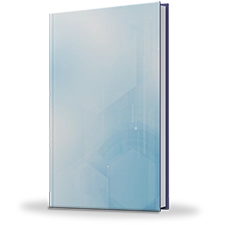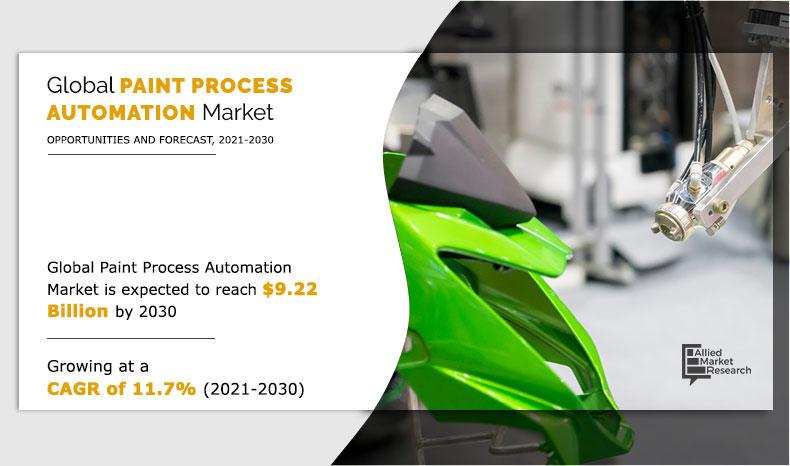Paint Process Automation Market Research, 2030
The global paint process automation market size was valued at $3.34 billion in 2020, and is projected to reach $9.22 billion by 2030, registering a CAGR of 11.7% from 2021 to 2030. Paint process automation is a method of painting or coating components, products, or equipment uniformly with the use of automated systems or robots. It has simplified the process of manual painting with improved quality, cost reductions, reduced waste, improved response time, increased safety, reduced energy costs, and increased production. Hence, manufacturers around the world are streamlining their painting processes by automating painting lines.
The introduction of paint process automation is increasing in factory automation with the emergence of Industry 4.0. Stable painting or coating quality and automation-based high-volume production are essential for mass production in manufacturing facilities across the world. Consequently, paint process automation has become increasingly popular in recent years.
Paint process automation offers consistent results that are difficult to achieve through the manual method, which is the prime reason that drives the paint process automation industry during the forecast period.
Further, it is a cost-effective painting process when compared with the traditional method, which accelerates the paint automation market growth rapidly. Moreover, the paint process automation can be customized according to industry-specific needs, which is advantageous for the market growth. Considering these factors, the paint process automation market revenue is estimated to experience gradual growth in the future.
Integration of advanced technologies with painting robots offers a lucrative growth opportunity for the paint process automation market during the forecast period. However, high installation cost acts as a major restraint for the market growth. Nonetheless, it enables sustainable manufacturing practices, thereby creating potential opportunities for the growth of the market.
The emergence of the global pandemic has acted as a prime drawback for the manufacturing and selling industries. Major economies across the world have faced major losses due to partial and complete lockdown, which hinders the growth of the paint process automation market. However, automation technologies have emerged as an invaluable asset for companies to tackle this pandemic. Hence, the surge in demand for the paint process automation industry is anticipated post-pandemic.
Segment Overview
The paint process automation market share is segmented into offering, purpose, vertical, type, and region.
Based on offering, it is fragmented into hardware, software, and services. The hardware is further sub-segmented into robots, controllers, atomizers, and others. The robot segment is further segmented into 4-axis, 6-axis, 7-axis, and others. The hardware segment dominated the market in terms of revenue in 2020 and is expected to follow the same trend during the forecast period. Based on purpose, the paint process automation market share is segregated into interior and exterior. The exterior segment dominated the market in terms of revenue in 2020 and is anticipated to witness significant market share during the forecast period
By Offering
Services segment is projected as one of the most lucrative segments.
By vertical, the market is divided into automotive, aviation, agriculture, textile, furniture, pharmaceutical, electronics, construction, and others. The market share for the electronic segment was the highest in 2020 and is expected to grow at a high CAGR from 2021 to 2030. By type, the market is divided into floor-mounted systems, wall-mounted systems, rail-mounted systems, and others. The market share for the floor-mounted systems segment was highest in 2020, and wall-mounted painting robots are expected to grow at a high CAGR from 2021 to 2030.
By Vertical
Automotive segment is expected to secure leading position during forecast period.
Region-wise, the paint process automation market trends are analyzed across North America (the U.S., Canada, and Mexico), Europe (the UK, Germany, France, Italy, and Rest of Europe), Asia-Pacific (China, Japan, India, South Korea, and Rest of Asia-Pacific), and LAMEA (Latin America, the Middle East, and Africa). The Asia-Pacific paint process automation market is expected to grow at the highest rate during the forecast period
By Region
Asia-Pacific would exhibit the highest CAGR of 12.6% during 2021-2030
Top Impacting Factors
Significant factors that impact the growth of the paint process automation market include consistent painting results, cost-effective painting processes, and the ability to meet industry-specific needs. However, high installation cost hampers the market growth. On the contrary, integration of advanced technologies with paint process automation assists in achieving sustainable goals, which are expected to offer lucrative opportunities for the paint process automation market during the forecast period.
Competition Analysis
Competitive analysis and profiles of the major paint process automation market players, such as ABB, CMA Robotics, DURR AG, Epistolio robot, FANUC AMERICA CORPORATION, Graco Inc., KAWASAKI HEAVY INDUSTRIES LTD., KUKA Aktiengesellschaft, Staubli International AG, and YASKAWA ELECTRIC PTE LTD., are provided in this report.
Key Benefits For Stakeholders
- This study comprises an analytical depiction of the paint process automation market Size along with the current trends and future estimations to depict the imminent investment pockets.
- The overall paint process automation market analysis is determined to understand the profitable trends to gain a stronger foothold.
- The report presents information related to key drivers, restraints, and opportunities with a detailed impact analysis.
- The current paint process automation market forecast is quantitatively analyzed from 2020 to 2030 to benchmark the financial competency.
- Porter’s five forces analysis illustrates the potency of the buyers and suppliers in the market.
- The report includes the paint process automation market share of key vendors and market trends.
Paint Process Automation Market Report Highlights
| Aspects | Details |
| By Offering |
|
| By purpose |
|
| By vertical |
|
| By Type |
|
| By Region |
|
| Key Market Players | KUKA AG, Kawasaki Heavy Industries, Ltd., ABB Ltd., EPISTOLIO Srl, FANUC Corporation, Graco Inc., CMA Robotics Spa, YASKAWA Electric Corporation, Staubli International AG, Durr AG |
Analyst Review
The most common form of industrial painting requires use of skilled labors. Moreover, it is a large-scale process that demands high levels of safety measures and protective gears and is prone to several errors that wastes resources in form of raw material, money, and time. However, automation of painting process is a boon to manufacturers. Paint process automation uses painting robots that are highly sophisticated for large-scale manufacturing operations. It is a customized automation that enhances efficiency, precision, safety, and programmability.
According to industry experts, paint process automation is a long-term investment and one of the important tools of increased efficiency. One of the major advantages offered is time, while other is uniformity. It can be used with paints as well as powder coatings. Intelligence and flexibility of robots allow it to manipulate flow rate, reduce wastage, and over-spray, as well as better reach into corners and other small details. Repeatability of automated spraying is paramount; once a robot is programmed, it coats millions of parts without variation. Standard paint savings when using robots as opposed to manual painters is 15–30%. These benefits propel growth of the position of paint process automation in various industry verticals.
The key players profiled in the report include ABB, CMA Robotics, DURR AG, Epistolio robot, FANUC AMERICA CORPORATION, Graco Inc., KAWASAKI HEAVY INDUSTRIES LTD., KUKA Aktiengesellschaft, Staubli International AG, and YASKAWA ELECTRIC PTE LTD.
The Paint Process Automation Market is estimated to grow at a CAGR of 11.7% from 2021 to 2030.
The Paint Process Automation Market is projected to reach $9.22 Billion by 2030.
Cost-effective painting processes, and ability to meet industry-specific needs. These factors are estimated to propel the Paint Process Automation Market growth
The key players profiled in the report include ABB, CMA Robotics, DURR AG, Epistolio robot, FANUC AMERICA CORPORATION, Graco Inc., KAWASAKI HEAVY INDUSTRIES LTD., KUKA Aktiengesellschaft, Staubli International AG, and YASKAWA ELECTRIC PTE LTD.
The automotive segment of the paint process automation market is projected to grow at a CAGR of 9.4% during the forecast period.
Loading Table Of Content...




